| Article ID | Journal | Published Year | Pages | File Type |
|---|---|---|---|---|
| 2847510 | Respiratory Physiology & Neurobiology | 2011 | 11 Pages |
To regulate the autonomic function, the vagus nerve transfers various sensory information from peripheral organs, and appropriate motor reflexes are produced in the neural circuit. The functional development of the vagal pathway during the early phase of embryonic development has long been unclear. Optical recording with voltage-sensitive dyes has provided a new approach to the analysis of the functional development of the embryonic central nervous system. In this review, we present recent progress in optical studies on the vagal pathway in the embryonic chick and rat brainstems. The topics include how neural excitability is initially expressed in the motor and sensory nuclei [e.g. the dorsal motor nucleus of the vagus nerve (DMNV) and the nucleus of the tractus solitarius (NTS)] and how synapse networks are formed in the primary and higher-ordered sensory nuclei [e.g. the parabrachial nucleus (PBN)]. We also refer to the functional development of the glossopharyngeal nuclei and compare the developmental steps with those of the vagal nuclei.
